


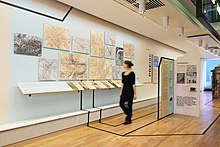
The Jewish Museum of Switzerland in Basel provides an overview of the religious and everyday history of the Jews in Basel and Switzerland using objects of ritual, art and everyday culture from the Middle Ages to the present.




The Jewish Museum of Switzerland in Basel provides an overview of the religious and everyday history of the Jews in Basel and Switzerland using objects of ritual, art and everyday culture from the Middle Ages to the present.
The museum opened in 1966 as the first Jewish museum in German-speaking Europe after the Second World War. [1] The initiative came from members of Espérance (a chevra kadisha) who visited Cologne to see the exhibition "Monumenta Judaica" in 1963/64. They discovered that many of the ritual objects on display came from the Basel Judaica collection and decided to present these objects permanently in a Jewish museum in Basel.
When it first opened, the museum occupied two rooms at Kornhausgasse 8. The interior designer Christoph Bernoulli furnished the space in an "objective" style. The founding director, Dr. Katia Guth-Dreyfus, headed the museum for four decades. In 2010 she was succeeded by Dr. Gaby Knoch-Mund. In 2015, Dr. Naomi Lubrich took over as director of the Jewish Museum of Switzerland. [2]
Since 2016, Lubrich has re-organized the permanent exhibit, attracted new visitors and gained the museum media attention. [3]
The first objects shown in the Jewish Museum's exhibition were Judaica collected by the Swiss Museum of Folklore (now Museum der Kulturen Basel). [4] The museum's collection expanded after 1966 to include objects from Basel and the Upper Rhine, from the two Surbtal villages Endingen and Lengnau as well as from the remainder of Switzerland and Europe. [5] A noteworthy find, when it comes to the Surbtal valley, are the "Lengnau Mappot", a collection of 218 Torah binders that span almost three centuries, making them the largest cohesive collection of mappot from a known community. [6]
Highlights of the museum's collection include silver ceremonial objects, richly embroidered textiles from the 17th to the 20th centuries and documents from the cultural history of the Jews in Switzerland. The monumental medieval gravestones and the Basel Hebrew prints are important historical testimonies. Documents on the Basel Zionist Congresses and original letters from Theodor Herzl, the author of "Der Judenstaat", show Basel as a city that made world politics. [7] The museum is also collecting contemporary objects — Judaica, art, and objects from everyday life. [8]
| Circumcision Bench | |
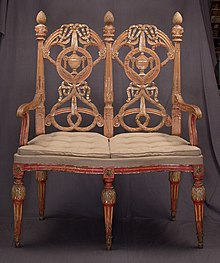 | This circumcision bench (or brit milah bench) was carved in 1791 and entered the museum's collection in 1973. [9] It is inscribed with words from the First Book of Moses: "You must circumcise the flesh of your foreskins, and it will be a symbol of the covenant between us. On the eighth day after birth, every male in every generation must be circumcised (Genesis 17:11)." [10] |
| Collotype from the First Zionist Congress | |
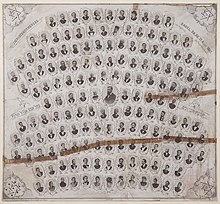 | The collotype process of the mid 19th century made it relatively easy to produce hundreds of photographs at a time. This collotype shows the 162 participants of the First Zionist Congress, which took place in Basel in 1897. While most participants were men, some women took part as well. Their photos are on the bottom row. Women were allowed to participate, but not to vote. [11] |
| J-stamped Passport | |
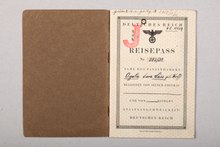 | On the 30th of December 1938, Agatha Süss's German passport was stamped with a "J" to mark her as Jewish. Because her daughter married a Swiss man, the 63-year old successfully procured a visa for Switzerland and was able to take up residence with her son-in-law in Basel, thus escaping the Holocaust. [12] |
| Mappa from Lengnau | |
 | A mappa (or wimpel) is made from the cloth used to swaddle a newborn boy on his Brit Milah, thus connecting the communal world of the synagogue with the life of the individual. This embroidered wimpel made of coarse linen dates back to 1744 and belongs to the "Lengnau Mappot." The inscription reads: "Samuel, son of Meir, who was born under a good star on Friday, Shabbat evening, 2nd Kislew 5505, may he lead a life with the Torah, the Chuppah and good deeds, Amen Selah." [13] Embroidered with colourful yarn, this wimpel depicts a vase of flowers. Symbolically it stands for the Torah, which is also seen as the tree of life. [14] |
| Pocket Watch from La Chaux-de-Fonds | |
 | This silver and brass pocket watch was made by Jules Levy in La Chaux-de-Fonds in 1901, as can be deduced from the inscription: "Jules Levy. Chaux de Fonds. Tischri 5662. Mon cher oncle." Levy's "dear uncle" was Aron Rhein. Tishri is the first month of the Jewish calendar year, falling between September and October. The hour numerals are represented by Hebrew characters. The Jewish community of La Chaux-de-Fonds was founded in 1833 and quickly grew, counting circa 900 members in 1900, when the local watch manufacturing industry was at its peak. [15] |
| Torah Mantle | |
 | This Torah mantle was found in the storage room of the synagogue in Endingen (AG) in 1967. The material was a French 18th century silk originally used as a ladies’ dress, perhaps even a wedding gown. It was repurposed as a Torah mantle, a controversial yet fairly common practice before the 20th century. [16] |
| Torah Shrine from Solothurn | |
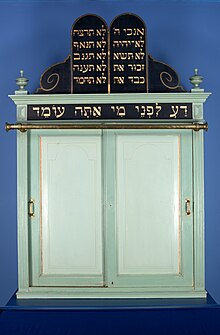 | This "aron ha kodesh", or "holy shrine", was made for the former prayer room of the Jewish community of Solothurn (SO), inaugurated in 1893. The inscription reads: "Know before whom you stand!" The small Jewish community had to give up its prayer room in 1986, and the furnishings and objects were divided between the Jewish Community of Berne (BE) and the Jewish Museum of Switzerland. [17] |
1976: 10 Years Jewish Museum of Switzerland (10 Jahre Jüdisches Museum der Schweiz)
1999: Tefillin
1999–2000: Signs of the Zodiac (Tierkreiszeichen)
2000: The Rabbis Ris. A Family in the Region (Die Rabbiner Ris. Eine Familie in der Region)
2002: Mesusot
2002–2003: Dining on Shabbat (Speisen am Schabbat)
2003–2004: Jewish Wedding Contracts from the Braginsky Collection, Zurich (Jüdische Hochzeitsverträge aus der Braginsky Collection, Zürich)
2004–2005: Anne Frank. A Family History across Borders (Anne Frank. Eine Familiengeschichte über Grenzen)
2005–2006: Chest on the Move. A Jewish Family History from Frankfurt and Basel (Truhe auf Wanderschaft. Eine jüdische Familiengeschichte aus Frankfurt und Basel)
2006–2007: Bringing it into the Light. Acquisitions of the Last 10 Years (Ins Licht gerückt. Sammlungszugänge der letzten 10 Jahre)
2007–2008: Endingen-Lengnau. Traces of the Jewish Rural Communities in Aargau (Endingen-Lengnau. Auf den Spuren der jüdischen Landgemeinden im Aargau)
2009–2009: Strange. Objects that are out of Line (Merkwürdig. Objekte, die aus der Reihe tanzen)
2010–2016: Congratulations. Special Exhibition on the 150th Birthday of Theodor Herzl (HERZLichen Glückwunsch. Sonderausstellung zum 150. Geburtstag von Theodor Herzl )
2010–2014: "...and Hanna and Sarah" installation by Renée Levy („…und Hanna und Sarah" Installation von Renée Levy)
2011: From New Moon to Full Moon (Von Neumond zu Vollmond)
2011–2012: In Transition. Bar and Bat Mitzvah (Am Übergang. Bar und Bat Mitzwa)
2012: 1001 Amulet. Protection and Magic - Faith or Superstition? (1001 Amulett. Schutz und Magie – Glaube oder Aberglaube?)
2014–2016: Wanted. Found. Partnership and Love in Judaism (Gesucht. Gefunden. Partnerschaft und Liebe im Judentum)
2016: Swiss Jews. 150 Years of Equal Rights / Voices for Emancipation (Schweizer Juden. 150 Jahre Gleichberechtigung / Stimmen zur Emanzipation)
2016: Jubilee! The Jewish Museum of Switzerland turns 50 (Jubiläum! Das Jüdische Museum der Schweiz wird 50)
2017: Altland. Theodor Herzls European Heritage (Altland. Theodor Herzls europäisches Erbe)
2017: Art after Chagall. The Century after the Breakthrough (in cooperation with Kunstmuseum Basel) (Kunst nach Chagall. Das Jahrhundert nach dem Durchbruch (in Zusammenarbeit mit dem Kunstmuseum Basel))
2018–2019: The Diary. How Otto Frank Brought Anne's Voice from Basel to the World (Das Tagebuch. Wie Otto Frank Annes Stimme aus Basel in die Welt brachte)
2019: ISREALITIES. Seven Photographic Journeys (ISREALITIES. Sieben fotografische Reisen)
2019–2020: Passports, Profiteers, Police. A Swiss War Secret (Pässe, Profiteure, Polizei. Ein Schweizer Kriegsgeheimnis)
2020: Pandemics and Poetics. A Jewish Dictionary (online) (Pandemie und Poesie. Ein jüdisches Lexikon (online))
2021–2024: Literally Jewish: A lexicological history. Installation in the new location at Vesalgasse 5.
2003: Jüdische Hochzeitsverträge aus Italien
2006: Truhe auf Wanderschaft. Eine jüdische Familiengeschichte aus Frankfurt und Basel
2006: Ins Licht gerückt. Sammlungszugänge der letzten 10 Jahre
2007: Endingen-Lengnau. Auf den Spuren der jüdischen Landgemeinden im Aargau
2010: HERZLichen Glückwunsch! Sonderausstellung zum 150. Geburtstag von Theodor Herzl
2011: Gaby Knoch-Mund et al., Am Übergang. Bar und Bat Mizwa. Wie werden jüdische Kinder und Jugendliche erwachsen? Basel. ISBN 9783033030251.
2013: 1001 Amulett. Schutz und Magie – Glaube oder Aberglaube
2014: Gaby Knoch-Mund, Gesucht. Gefunden. Partnerschaft und Liebe im Judentum, Basel. ISBN 9783033046337.
2018: Caspar Battegay, Naomi Lubrich, Jüdische Schweiz. 50 Objekte erzählen Geschichte / Jewish Switzerland: 50 Objects Tell their Stories, Basel, Christoph Merian Verlag. ISBN 978-3-85616-847-6 [18]
2020: Fabio Luks, CHAI – חי. Oder wenn Grabsteine vom Leben erzählen/CHAI - חי. Or when Gravestones Speak of Life, Biel, edition clandestin. ISBN 978-3-905297-99-7. [19]
2020: Pandemie und Poesie. Ein jüdisches Lexikon. Pandemics and Poetics. A Jewish Dictionary. Biel, edition clandestin. ISBN 978-3907262085 [20]
2021: Naomi Lubrich: Passports, Profiteers, Police. A Swiss War Secret. edition clandestin ISBN 978-3-907262-09-2
2022: Naomi Lubrich (Ed.): Birth Culture: Artifacts from rural Switzerland and Environs. Schwabe Verlag, Basel. ISBN 978-3-7965-4607-5
2022: Naomi Lubrich (Ed.): What's in a Name? 25 Jewish Stories. edition clandestin, ISBN 978-3-907262-34-4

A Torah ark refers to an ornamental chamber in the synagogue that houses the Torah scrolls.

The Zionist Congress was established in 1897 by Theodor Herzl as the supreme organ of the Zionist Organization (ZO) and its legislative authority. In 1960 the names were changed to World Zionist Congress and World Zionist Organization (WZO), respectively. The World Zionist Organization elects the officers and decides on the policies of the WZO and the Jewish Agency, including "determining the allocation of funds." The first Zionist Congress was held in Basel, Switzerland in 1897. Any Jew over age 18 who belongs to a Zionist association is eligible to vote, and the number of elected delegates to the Congress is 500. 38% of the delegates are allocated to Israel, 29% to the United States of America, and 33% to the remainder of the countries of the Diaspora. In addition there are about 100 delegates which are appointed by International Organizations affiliated with WZO.

The Nuremberg Chronicle is an illustrated encyclopedia consisting of world historical accounts, as well as accounts told through biblical paraphrase. Subjects include human history in relation to the Bible, illustrated mythological creatures, and the histories of important Christian and secular cities from antiquity. Finished in 1493, it was originally written in Latin by Hartmann Schedel, and a German version was translated by Georg Alt. It is one of the best-documented early printed books—an incunabulum—and one of the first to successfully integrate illustrations and text.

The Basel city walls are a complex of walls surrounding the central part of the Swiss city of Basel, only partially preserved today. The first city wall was completed around 1080 under bishop Burkhard von Fenis. A newer wall was constructed around 1230, which is known as the Inner Wall. Its course was mostly identical to the Burkhard wall. In 1362 the construction of a larger wall complex began due to the city's expansion; it was completed in 1398, and is known as the Outer Wall. In 1859 the city's executives decided to raze the inner wall and gates to the ground. Three outer city gates and a short piece of the wall were saved from demolition and are being preserved as part of the city's heritage.
Between the 12th century and modern times, the Swiss city of Basel has been home to three Jewish communities. The medieval community thrived at first but ended violently with the Basel massacre of 1349. As with many of the violent anti-Judaic events of the time, it was linked to the outbreak of the Black Death. At the end of the 14th century, a second community formed. But it was short-lived and disbanded before the turn of the century. For the following 400 years, there was no Jewish community in Basel. Today, there are several communities, ranging from liberal to religious to orthodox, and there are still more Jews who don’t belong to any community.

The Basel Massacre was an anti-Semitic episode in Basel, which occurred in 1349 in connection with alleged well poisoning as part of the Black Death persecutions, carried out against the Jews in Europe at the time of the Black Death. A number of Jews, variously given as between 300 and 600 or 50 to 70 were burned alive, after being locked in a wooden structure built on a nearby island in the Rhine. Jewish children were apparently spared, but forcibly baptized and sent to monasteries. The event occurred on January 9.
Judenporzellan is a designation for inferior porcelain produced by the Royal Porcelain Factory owned by Frederick the Great in the late 18th century. To increase business, he decreed in 1769 that a tax on Jews in the form of coerced purchases from his factory would be levied on Jews in order to obtain marriage, death, business and other certificates and permits. Some accounts claim that the twenty porcelain monkeys belonging to the heirs of Moses Mendelssohn (1729–1786) are Judenporzellan, although some authorities doubt the authenticity of these family stories based on chronology and provenance—at least one of the monkeys is of Meissen manufacture.

The history of the Jews in Switzerland extends back at least a thousand years. Jews and Judaism have been present in the territory of what is now Switzerland since before the emergence of the medieval Old Swiss Confederacy in the 13th century.

Gailingen am Hochrhein is a village in the district of Konstanz in Baden-Württemberg, in southern Germany.

A Shabbat lamp is a special lamp that has movable parts to expose or block out its light so it can be turned "on" or "off" while its power physically remains on. This enables the lamp's light to be controlled by those Shabbat observant Jews who accept this use, to make a room dark or light during Shabbat without actually switching the electrical power on or off, an act prohibited by Orthodox Judaism on both Shabbat and the Jewish Holidays.
Ebel is a Swiss luxury watch company that was founded in 1911 at La Chaux-de-Fonds in the canton of Neuchâtel, Switzerland.

Alis Guggenheim was a Swiss painter, and sculptor.
The Ditisheims are a prominent dynasty of Swiss Jewish industrialists. Immigrating first to Hégenheim, France, then to La Chaux-de-Fonds, Switzerland in 1858 to escape religious persecution, Jacques Ditisheim and his descendants were instrumental in the development of the Swiss watchmaking industry. The Ditisheims have links with other prominent industrialist families of Swiss watchmaking, including the Gallets, Eberhards, Vogels and Blums, forming a close inner circle which led the country's industry during the 19th and 20th centuries.

Stadtcasino Basel is a concert hall in Basel, Switzerland.

The Lengnau mappot; a collection of 218 Torah binders, were discovered in the 1960s in the women's gallery of the synagogue in Lengnau (Aargau). In 1967, the wimpels were the subject of research by Florence Guggenheim-Grünberg, whose contribution was the first systematic description of this kind of collection. Today the Lengnau mappot belong to the Jewish Museum of Switzerland.
The history of the Jews in Geneva dates back to at least the Middle Ages. Geneva is the only place in present day Switzerland where Jews had to live in a ghetto. It was not until the 19th century that Jews were granted freedom of establishment, but numerous Jews were able to live in Carouge towards the end of the 18th century. Today, Geneva is one of the Swiss cities where Judaism is most prevalent and is home to diverse Jewish communities and establishments.
The history of the Jews in Zürich dates back to at least the Middle Ages. Since the early 20th century, Zürich, Switzerland, has been among the Swiss cities where Judaism is most prevalent.
The history of the Jews in Bern dates back to at least the Middle Ages. Following the expulsion and persecution of Jews during and after the Black Death epidemic, few Jews were able to live or work in the canton until the 19th century. The Jewish community of Bern was founded in 1948 and is active to this day.

The dice toll was a regional supplement to the Leibzoll with which Jews had to buy free passage across regional borders. It was widespread in certain regions of Europe from the Middle Ages until the 17th century. While the Leibzoll was a monetary payment, the dice toll was comparatively worthless. The dice payment was often demanded of Jews crossing customs borders, and also played a role outside of the official customs trade as a popular form of anti-Jewish harassment.
Raphael Ris was a Swiss rabbi and kabbalist.
{{cite book}}: CS1 maint: location missing publisher (link){{cite book}}: CS1 maint: location missing publisher (link) CS1 maint: numeric names: authors list (link){{cite book}}: CS1 maint: location missing publisher (link) CS1 maint: numeric names: authors list (link){{cite book}}: CS1 maint: location missing publisher (link) CS1 maint: numeric names: authors list (link){{cite book}}: CS1 maint: location missing publisher (link){{cite web}}: CS1 maint: multiple names: authors list (link){{cite book}}: CS1 maint: location missing publisher (link) CS1 maint: numeric names: authors list (link){{cite book}}: CS1 maint: location missing publisher (link) CS1 maint: numeric names: authors list (link){{cite book}}: CS1 maint: location missing publisher (link) CS1 maint: numeric names: authors list (link){{cite book}}: CS1 maint: location missing publisher (link) CS1 maint: multiple names: authors list (link) CS1 maint: numeric names: authors list (link)